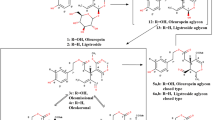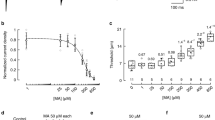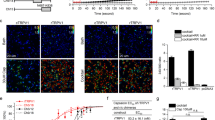Abstract
In traditional folk medicine, Xanthoxylum plants are referred to as 'toothache trees' because their anesthetic or counter-irritant properties render them useful in the treatment of pain. Psychophysical studies have identified hydroxy-α-sanshool as the compound most responsible for the unique tingling and buzzing sensations produced by Szechuan peppercorns or other Xanthoxylum preparations. Although it is generally agreed that sanshool elicits its effects by activating somatosensory neurons, the underlying cellular and molecular mechanisms remain a matter of debate. Here we show that hydroxy-α-sanshool excites two types of sensory neurons, including small-diameter unmyelinated cells that respond to capsaicin (but not mustard oil) as well as large-diameter myelinated neurons that express the neurotrophin receptor TrkC. We found that hydroxy-α-sanshool excites neurons through a unique mechanism involving inhibition of pH- and anesthetic-sensitive two-pore potassium channels (KCNK3, KCNK9 and KCNK18), providing a framework for understanding the unique and complex psychophysical sensations associated with the Szechuan pepper experience.
This is a preview of subscription content, access via your institution
Access options
Subscribe to this journal
Receive 12 print issues and online access
$209.00 per year
only $17.42 per issue
Buy this article
- Purchase on Springer Link
- Instant access to full article PDF
Prices may be subject to local taxes which are calculated during checkout






Similar content being viewed by others
References
Meyer, R.A., Ringkamp, M., Campbell, J.N. & Raja, S.N. Peripheral mechanisms of cutaneous nociception. in Textbook of Pain (eds. McMahon, S.B. & Koltzenburg, M.) 3–34 (Elsevier, Philadelphia, 2006).
Julius, D. & Basbaum, A.I. Molecular mechanisms of nociception. Nature 413, 203–210 (2001).
Fields, H.L. Pain (McGraw-Hill, New York, 1987).
Snyder, S.H. Opiate receptors and internal opiates. Sci. Am. 236, 44–56 (1977).
Julius, D. From peppers to peppermints: natural products as probes of the pain pathway. Harvey Lect. 101, 89–115 (2005).
Woolf, C.J. & Ma, Q. Nociceptors–noxious stimulus detectors. Neuron 55, 353–364 (2007).
Foster, S. & Duke, J.A. Eastern/Central Medicinal Plants and Herbs (Houghton-Mifflin, New York, 2000).
McGee, H. On Food and Cooking: The Science and Lore of the Kitchen (Scribner, New York, 2004).
Sugai, E. et al. Pungent qualities of sanshool-related compounds evaluated by a sensory test and activation of rat TRPV1. Biosci. Biotechnol. Biochem. 69, 1951–1957 (2005).
Sugai, E., Morimitsu, Y. & Kubota, K. Quantitative analysis of sanshool compounds in Japanese pepper (Xanthoxylum piperitum DC.) and their pungent characteristics. Biosci. Biotechnol. Biochem. 69, 1958–1962 (2005).
Bryant, B.P. & Mezine, I. Alkylamides that produce tingling paresthesia activate tactile and thermal trigeminal neurons. Brain Res. 842, 452–460 (1999).
Koo, J.Y. et al. Hydroxy-alpha-sanshool activates TRPV1 and TRPA1 in sensory neurons. Eur. J. Neurosci. 26, 1139–1147 (2007).
Kobayashi, K. et al. Distinct expression of TRPM8, TRPA1, and TRPV1 mRNAs in rat primary afferent neurons with aδ/c-fibers and colocalization with trk receptors. J. Comp. Neurol. 493, 596–606 (2005).
Ramsey, I.S., Delling, M. & Clapham, D.E. An introduction to TRP channels. Annu. Rev. Physiol. 68, 619–647 (2006).
Bautista, D.M. et al. TRPA1 mediates the inflammatory actions of environmental irritants and proalgesic agents. Cell 124, 1269–1282 (2006).
Delmas, P. & Brown, D.A. Pathways modulating neural KCNQ/M (Kv7) potassium channels. Nat. Rev. Neurosci. 6, 850–862 (2005).
Goldstein, S.A., Bockenhauer, D., O'Kelly, I. & Zilberberg, N. Potassium leak channels and the KCNK family of two-P-domain subunits. Nat. Rev. Neurosci. 2, 175–184 (2001).
Lesage, F. & Lazdunski, M. Molecular and functional properties of two-pore-domain potassium channels. Am. J. Physiol. Renal Physiol. 279, F793–F801 (2000).
Alloui, A. et al. TREK-1, a K+ channel involved in polymodal pain perception. EMBO J. 25, 2368–2376 (2006).
Kang, D. & Kim, D. TREK-2 (K2P10.1) and TRESK (K2P18.1) are major background K+ channels in dorsal root ganglion neurons. Am. J. Physiol. Cell Physiol. 291, C138–C146 (2006).
Dobler, T.M. et al. TRESK two-pore-domain K+ channels constitute a significant component of background potassium currents in murine DRG neurones. J. Physiol. (Lond.) 585, 867–879 (2007).
Duprat, F. et al. TASK, a human background K+ channel to sense external pH variations near physiological pH. EMBO J. 16, 5464–5471 (1997).
Kim, Y., Bang, H. & Kim, D. TASK-3, a new member of the tandem pore K+ channel family. J. Biol. Chem. 275, 9340–9347 (2000).
Sano, Y. et al. A novel two-pore domain K+ channel, TRESK, is localized in the spinal cord. J. Biol. Chem. 278, 27406–27412 (2003).
Liu, C., Au, J.D., Zou, H.L., Cotten, J.F. & Yost, C.S. Potent activation of the human tandem pore domain K channel TRESK with clinical concentrations of volatile anesthetics. Anesth. Analg. 99, 1715–1722 (2004).
Patel, A.J. et al. Inhalational anesthetics activate two-pore-domain background K+ channels. Nat. Neurosci. 2, 422–426 (1999).
Talley, E.M. & Bayliss, D.A. Modulation of TASK-1 (Kcnk3) and TASK-3 (Kcnk9) potassium channels: volatile anesthetics and neurotransmitters share a molecular site of action. J. Biol. Chem. 277, 17733–17742 (2002).
Kang, D., Han, J., Talley, E.M., Bayliss, D.A. & Kim, D. Functional expression of TASK-1/TASK-3 heteromers in cerebellar granule cells. J. Physiol. (Lond.) 554, 64–77 (2004).
Caterina, M.J. et al. Impaired nociception and pain sensation in mice lacking the capsaicin receptor. Science 288, 306–313 (2000).
Kwan, K.Y. et al. TRPA1 contributes to cold, mechanical, and chemical nociception but is not essential for hair-cell transduction. Neuron 50, 277–289 (2006).
Brickley, S.G. et al. TASK-3 two-pore domain potassium channels enable sustained high-frequency firing in cerebellar granule neurons. J. Neurosci. 27, 9329–9340 (2007).
Han, J., Truell, J., Gnatenco, C. & Kim, D. Characterization of four types of background potassium channels in rat cerebellar granule neurons. J. Physiol. (Lond.) 542, 431–444 (2002).
Millar, J.A. et al. A functional role for the two-pore domain potassium channel TASK-1 in cerebellar granule neurons. Proc. Natl. Acad. Sci. USA 97, 3614–3618 (2000).
Peters, H.C., Hu, H., Pongs, O., Storm, J.F. & Isbrandt, D. Conditional transgenic suppression of M channels in mouse brain reveals functions in neuronal excitability, resonance and behavior. Nat. Neurosci. 8, 51–60 (2005).
Bargmann, C.I. Comparative chemosensation from receptors to ecology. Nature 444, 295–301 (2006).
Chandrashekar, J., Hoon, M.A., Ryba, N.J. & Zuker, C.S. The receptors and cells for mammalian taste. Nature 444, 288–294 (2006).
McMahon, S.B., Bennett, D.L.H. & Bevan, S. Inflammatory mediators and modulators of pain. in Textbook of Pain (eds. McMahon, S.B. & Koltzenburg, M.) 49–72 (Elsevier, Philadelphia, 2006).
Aller, M.I. et al. Modifying the subunit composition of TASK channels alters the modulation of a leak conductance in cerebellar granule neurons. J. Neurosci. 25, 11455–11467 (2005).
Kato, A.S. et al. New transmembrane AMPA receptor regulatory protein isoform, gamma-7, differentially regulates AMPA receptors. J. Neurosci. 27, 4969–4977 (2007).
Almers, W. & Neher, E. The Ca signal from fura-2 loaded mast cells depends strongly on the method of dye-loading. FEBS Lett. 192, 13–18 (1985).
Feliciangeli, S. et al. Does sumoylation control K2P1/TWIK1 background K+ channels? Cell 130, 563–569 (2007).
Funfschilling, U. et al. TrkC kinase expression in distinct subsets of cutaneous trigeminal innervation and nonneuronal cells. J. Comp. Neurol. 480, 392–414 (2004).
Acknowledgements
We are grateful to S. Yost (University of California, San Francisco) and D. Kim (Rosalind Franklin University) for providing KCNK6 and KCNK16 cDNAs, respectively; H. Haeberle and E. Lumpkin (University of California, San Francisco, and Baylor College of Medicine) for TrkC-GFP mice; A. Tzingounis and A. Priel for helpful discussion; and J. Poblete for expert technical assistance. This work was supported by grants from the NIH (D.J. and R.A.N.), a Burroughs Welcome Fund Career Award in Biomedical Sciences (D.M.B.) and an NSF Graduate Research Fellowship (A.D.M.).
Author information
Authors and Affiliations
Contributions
D.M.B. and Y.M.S. designed and carried out cellular physiology and histological studies involving native and cloned ion channels; D.M.B. designed and carried out behavioral experiments; D.M.B., Y.M.S. and A.D.M. carried out experiments involving analysis of CGNs; J.L.G. and J.A.Z. designed and effected purification procedures and chemical analysis of sanshool compounds; P.R.T. contributed to gene cloning and electrophysiological analysis; D.M.B., Y.M.S. and D.J. wrote the manuscript; R.A.N. and D.J. provided advice and guidance throughout.
Corresponding author
Supplementary information
Supplementary Text and Figures
Supplementary Figures 1–6 and Supplementary Tables 1 and 2 (PDF 1834 kb)
Supplementary Movie 1
Both wild type and TRPV1/TRPA1 double mutant mice display aversion to sanshool. The first segment shows a TRPV1/TRPA1 double mutant mouse drinking saccharine-containing water (vehicle). The second segment shows the same mouse drinking saccharine-containing water laced with sanshool (1 mM). Behavior did not differ from that of wild type littermates. The third segment shows the same TRPV1/TRPA1 double mutant mouse drinking saccharine-containing water laced with capsaicin (1 μM) and mustard oil (100 μM). As expected, no aversive response was observed. In contrast, the final segment shows robust aversion by a wild type littermate after briefly sampling saccharine-containing water laced with capsaicin (1 μM) and mustard oil (100 μM). Quantification of these behaviors is shown in Fig. 3d. (MOV 16637 kb)
Rights and permissions
About this article
Cite this article
Bautista, D., Sigal, Y., Milstein, A. et al. Pungent agents from Szechuan peppers excite sensory neurons by inhibiting two-pore potassium channels. Nat Neurosci 11, 772–779 (2008). https://doi.org/10.1038/nn.2143
Received:
Accepted:
Published:
Issue Date:
DOI: https://doi.org/10.1038/nn.2143
This article is cited by
-
Nutrigenomics reveals potential genetic underpinning of diverse taste preference of Chinese men
Genes & Genomics (2021)
-
Altered functional properties of a missense variant in the TRESK K+ channel (KCNK18) associated with migraine and intellectual disability
Pflügers Archiv - European Journal of Physiology (2020)
-
Sanshool improves UVB-induced skin photodamage by targeting JAK2/STAT3-dependent autophagy
Cell Death & Disease (2019)
-
Anionic Phospholipids Bind to and Modulate the Activity of Human TRESK Background K+ Channel
Molecular Neurobiology (2019)
-
Characterization and Evaluation of Changes in the Aroma-Active Components in Szechuan Pepper (Zanthoxylum bungeanum Maxim) Under Different Cooking Temperatures Using Gas Chromatography-Olfactometry
Chemosensory Perception (2019)



